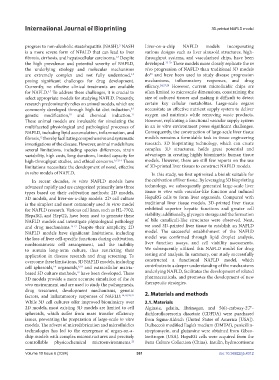Page 369 - IJB-10-6
P. 369
International Journal of Bioprinting 3D-printed NAFLD model
progress to non-alcoholic steatohepatitis (NASH). NASH Liver-on-a-chip NAFLD models incorporating
2
is a more severe form of NFALD that can lead to liver various designs such as liver sinusoid structures, high-
fibrosis, cirrhosis, and hepatocellular carcinoma. Despite throughput systems, and vascularized chips, have been
1,3
the high prevalence and potential severity of NAFLD, developed. 23-25 These models more closely replicate the in
the underlying etiology and molecular mechanisms vivo progression of NAFLD than traditional 3D models
are extremely complex and not fully understood, do and have been used to study disease progression
26
4,5
posing significant challenges for drug development. mechanisms, inflammatory responses, and drug
Currently, no effective clinical treatments are available efficacy. 24,27,28 However, current microfluidic chips are
6,7
for NAFLD. To address these challenges, it is crucial to often limited to microscale dimensions, constraining the
select appropriate models for studying NAFLD. Presently, size of cultured tissues and making it difficult to detect
research predominantly relies on animal models, which are certain key cellular metabolites. Large-scale organs
commonly developed through high-fat diet induction, necessitate an effective nutrient supply system to deliver
8,9
genetic modification, and chemical induction. oxygen and nutrients while removing waste products.
11
10
These animal models are invaluable for simulating the However, replicating a functional vascular supply system
multifaceted physiological and pathological processes of in an in vitro environment poses significant challenges.
NAFLD, including lipid accumulation, inflammation, and Consequently, the construction of large-scale liver tissue
fibrosis, thereby facilitating comprehensive and systematic models remains a formidable task in tissue engineering
12
investigations of the disease. However, animal models have research. 3D bioprinting technology, which can create
several limitations, including species differences, strain complex 3D structures, holds great potential and
variability, high costs, long durations, limited capacity for advantages in creating highly biomimetic human tissue
high-throughput studies, and ethical concerns. 6,13,14 These models. However, there are still few reports on the use
limitations necessitate the development of novel, effective of 3D-printed liver tissues to construct NAFLD models.
in vitro models of NAFLD. In this study, we first optimized a bioink suitable for
In recent decades, in vitro NAFLD models have the cultivation of liver tissue. By leveraging 3D bioprinting
advanced rapidly and are categorized primarily into three technology, we subsequently generated large-scale liver
types based on their cultivation methods: 2D models, tissue in vitro with vascular-like function and induced
3D models, and liver-on-a-chip models. 2D cell culture HepaRG cells to form liver organoids. Compared with
is the simplest and most commonly used in vitro model traditional liver tissue models, 3D-printed liver tissue
for NAFLD research. Various cell lines, such as HL-7702, exhibited superior hepatic functions and greater cell
HepaRG, and HepG2, have been used to generate these viability; additionally, glycogen storage and the formation
NAFLD models and investigate physiological pathology of bile canaliculi-like structures were observed. Next,
and drug mechanisms. 15-17 Despite their simplicity, 2D we used 3D-printed liver tissue to establish an NAFLD
NAFLD models have significant limitations, including model. The successful establishment of the NAFLD
the loss of liver cell-specific functions during cultivation, model was confirmed through lipid droplet analysis,
nonbiomimetic cell arrangement, and the inability liver function assays, and cell viability assessments.
to sustain long-term culture, thus restricting their We subsequently utilized this NAFLD model for drug
application in disease research and drug screening. To testing and analysis. In summary, our study successfully
overcome these limitations, 3D NAFLD models, including constructed a functional NAFLD model, which
cell spheroids, organoids, 6,18 and extracellular matrix- contributes to a deeper understanding of the mechanisms
14
based 3D culture methods, have been developed. These underlying NAFLD, facilitates the development of related
19
3D models provide a more accurate simulation of the in pharmaceuticals, and promotes the development of new
vivo environment and are used to study the pathogenesis, therapeutic strategies.
drug treatment, development mechanisms, genetic
factors, and inflammatory responses of NAFLD. 14,18,20,21 2. Materials and methods
While 3D cell cultures offer improved biomimicry over 2.1. Materials
2D models, most existing 3D models are limited to cell Alginate, gelatin, fibrinogen, and 5(6)-carboxy-2’,7’-
spheroids, which suffer from mass transfer efficiency dichlorofluorescein diacetate (CDFDA) were purchased
issues, preventing the preparation of large-scale in vitro from Sigma-Aldrich (United States of America [USA]).
models. The advent of microfabrication and microfluidics Dulbecco’s modified Eagle’s medium (DMEM), penicillin-
technologies has led to the emergence of organ-on-a- streptomycin, and glutamine were obtained from Gibco-
chip models with complex microstructures and precisely Invitrogen (USA). HepaRG cells were acquired from the
controllable physicochemical microenvironments. Bena Culture Collection (China). Insulin, hydrocortisone
22
Volume 10 Issue 6 (2024) 361 doi: 10.36922/ijb.4312

